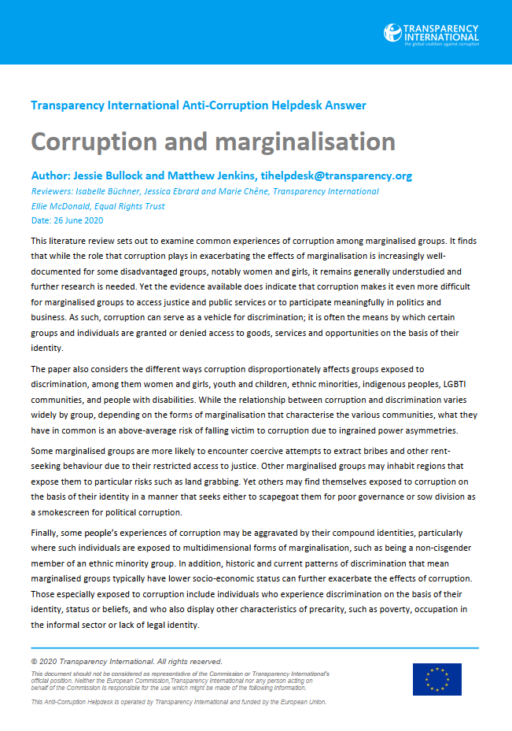
This Anti-Corruption Helpdesk brief was produced in response to a query from one of Transparency International’s national chapters. The Anti-Corruption Helpdesk is operated by Transparency International and funded by the European Union.
Query
What is the relationship between corruption and marginalisation, and how do marginalised groups experience corruption?
Contents
- Definitions and terminology
- Introduction
- Corruption and marginalised groups
- Corruption and multidimensional marginalisation
- References
Main points
- Marginalisation can exacerbate the effects of corruption, making it even more difficult for groups exposed to discrimination to access justice and public services, or to participate meaningfully in politics and business.
- The costs of corruption are particularly onerous for marginalised communities. Yet while corruption typically affects all disadvantaged groups disproportionately, it does so in unique ways, depending on contextual legal, socio-economic and institutional factors, as well as how group identity is politicised.
- The costs of corruption can be cumulative: if an individual is a member of multiple marginalised groups, they may be even more exposed to extortive forms of corruption.
Summary
This literature review sets out to examine common experiences of corruption among marginalised groups. It finds that while the role that corruption plays in exacerbating the effects of marginalisation is increasingly well-documented for some disadvantaged groups, notably women and girls, it remains generally understudied and further research is needed. Yet the evidence available does indicate that corruption makes it even more difficult for marginalised groups to access justice and public services or to participate meaningfully in politics and business. As such, corruption can serve as a vehicle for discrimination; it is often the means by which certain groups and individuals are granted or denied access to goods, services and opportunities on the basis of their identity.
The paper also considers the different ways corruption disproportionately affects groups exposed to discrimination, among them women and girls, youth and children, ethnic minorities, indigenous peoples, LGBTI communities, and people with disabilities. While the relationship between corruption and discrimination varies widely by group, depending on the forms of marginalisation that characterise the various communities, what they have in common is an above-average risk of falling victim to corruption due to ingrained power asymmetries.
Some marginalised groups are more likely to encounter coercive attempts to extract bribes and other rent-seeking behaviour due to their restricted access to justice. Other marginalised groups may inhabit regions that expose them to particular risks such as land grabbing. Yet others may find themselves exposed to corruption on the basis of their identity in a manner that seeks either to scapegoat them for poor governance or sow division as a smokescreen for political corruption.
Finally, some people’s experiences of corruption may be aggravated by their compound identities, particularly where such individuals are exposed to multidimensional forms of marginalisation, such as being a non-cisgender member of an ethnic minority group. In addition, historic and current patterns of discrimination that mean marginalised groups typically have lower socio-economic status can further exacerbate the effects of corruption. Those especially exposed to corruption include individuals who experience discrimination on the basis of their identity, status or beliefs, and who also display other characteristics of precarity, such as poverty, occupation in the informal sector or lack of legal identity.
Authors
Jessie Bullock and Matthew Jenkins, [email protected]
Reviewers:
Isabelle Büchner, Jessica Ebrard and Marie Chêne, Transparency International
Ellie McDonald, Equal Rights Trust
Date
08/07/2020

